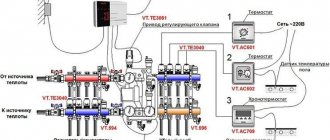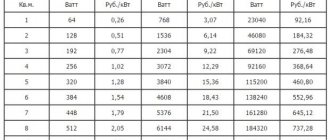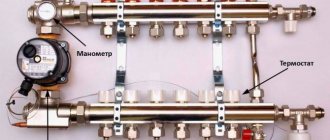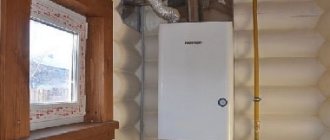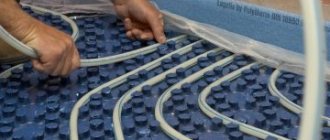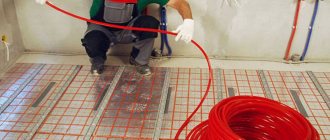Heated floors are not only a kind of addition to traditional wall-mounted radiators, but can also be an independent source of heat if desired. However, most often these two elements work in parallel, which is why a mixing unit for heated floors is needed. What is this equipment, how is it installed and on what principle does it work?
Mixing unit for heated floors
Why do you need a mixer and how does it work?
First of all, the home handyman needs to understand the operating principle of the heated floor mixing unit. The scope of its use is only the design of water heated floors.
The heating circuit includes a boiler that heats the liquid, heating circuits and radiators. The unit usually heats the coolant to 95 degrees. In this case, the ideal temperature is considered to be no more than 31 degrees, since for comfortable movement on the floor surface it should not be hot or cold.
You should also pay attention to:
- type and thickness of the floor covering;
- the height of the cement screed in which the pipes are laid.
Taking into account the above, it is clear that the most suitable operating temperature for heating circuits is between 35 and 55 degrees. But the liquid in the boiler is too hot. Therefore, to reduce the degree of heating, a mixing unit is used, in which water of high and low temperatures is mixed.
Already in a cooled state, the coolant enters the floor pipeline. Thanks to the presence of a mixer, the heat supply system functions correctly and without problems. By the way, there are heated floors that work without this device. But they are equipped with a mixing unit for the boiler, and then the working environment is heated to the optimal temperature.
Rules for choosing a collector
You can assemble a manifold for a warm water floor with your own hands or buy it ready-made
In the first case, it is important that all components are produced by one manufacturer. Some companies produce unique connecting elements that do not fit with parts from other suppliers, which threatens the assembled unit with loss of tightness
In the second case, when choosing equipment, you need to take into account several important points. First of all, you need to decide on the material from which the collector is made. It could be:
- copper;
- steel;
- brass;
- polymer.
In addition, collectors differ in the number of connected circuits, the number of which can vary from 2 to 12. The choice of device is based on an accurate calculation of the main parameters of the system and the required additional functions. Be sure to take into account:
- number of heating circuits, their length and transmission capacity;
- maximum pressure;
- ability to add branches;
- the presence of elements that automatically control the operation of the device;
- amount of electricity consumed;
- internal diameter of the collector.
The latter indicator should be selected so as to ensure maximum coolant flow in all heating circuits. The efficiency of the unit largely depends on the laying pitch, diameter and length of the pipes included in the heating circuit.
At the system design stage, these parameters must also be calculated. This is a rather labor-intensive undertaking that is best left to specialists. You can make the calculation using a special calculator program that can be found on the Internet.
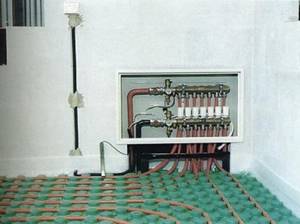
The collector will work most efficiently if heating circuits of equal length are connected to it. To do this, you may have to split too long branches into several short ones.
When making calculations, it is very important to take into account all system parameters. Otherwise, it will work unproductively: there may be insufficient coolant circulation or leakage, and a “thermal zebra” may also appear, as experts call uneven heating of the surface
To correctly determine the length of the circuit and the pipe laying pitch, you will need the following data:
- type of finishing floor covering;
- area of the room with a plan for the arrangement of large furniture and household appliances;
- pipe diameter and material;
- heating boiler power;
- type of thermal insulation used.
When making calculations, we must take into account that there should be no pipe joints in the circuit, since the use of couplings and connections under a concrete screed is strictly prohibited. In addition, we take into account the hydraulic resistance of the coolant, which will increase with each turn of the branch and as its length increases.
It is optimal if only circuits of equal length are connected to one collector. Perhaps the best solution for long branches is to divide them into several small ones.
Thermal mixing unit connection diagram
In order to connect the heated floor covering structure to the boiler, work is carried out according to the diagram of the heated floor mixing unit, depending on the heating system, which can be one-pipe or two-pipe. For a single-pipe version, you need to constantly keep the bypass open, but for a two-pipe version, you do not.
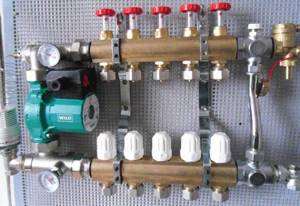
The project can be either elementary or contain a number of additional devices. In any case, thermostats, valves and devices that control the flow of the medium must be installed for the collector group. Mixing of the coolant can be carried out either at all outlets from the collector, or in front of them.
DIY mixing unit assembly
Since their prices are high, many owners find it more profitable to assemble a mixing unit for a heated floor with their own hands. In addition, sometimes it is impossible to find a regulator that has the required number of inputs. In such a situation, you need to purchase combs and install them yourself.
To assemble the unit, you need to prepare:
- two- or three-way valve;
- manual air vent;
- special nuts;
- clamps;
- return valve;
- ball valve;
- tees;
- circulation pumping equipment;
- temperature measuring devices.

The work is carried out in stages:
- Manufacturer manufacturing . It can be assembled by soldering polypropylene tees, or by twisting the tees, and their diameter should be ¾ inch. When using soldering technology, the cost of the collector will be more expensive, since MRN, which has a high price, must be installed on all branches of the comb. The best choice is to use tees - they need to be selected correctly. For a comb, parts with one internal end and two external ends are well suited. They are twisted together using tow.
- Creation of a hydraulic arrow . It can be made without a three-way valve. To do this, it is enough to use the control valve used for heating radiators. You will also need 2 tees as in the case of combs and 2 connecting nipples with external and internal threads, 50 centimeters long. The assembly is carried out on tow: nipples are screwed in on both sides of the tap, and then one tee is attached to them.
- Pump installation . You cannot make a pumping unit for a heated floor with your own hands - you can only purchase it (read: “Why do you need a pumping and mixing unit for a heated floor - operating principle, selection, installation rules”). The pump is mounted at the bottom of the hydraulic needle using the detachable connections included in the kit. It can also be used instead of a hydraulic gun and it will function no worse than it.
- Connection to hydraulic arrow combs . It is advisable to use detachable connections. If the pump is a separate unit, then a pipe is needed. Its length should be equal to the same parameter for the pump. The pipe is placed on the supply, and a manifold is connected to it - it is for this reason that it is more economical to use pumping equipment instead of a hydraulic arrow. Next, the combs are equipped with Mayevsky taps, control valves, or automatic air release.
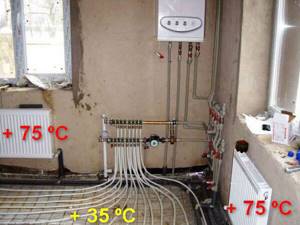
Then the homemade mixing unit for heated floors is placed in a special cabinet and connected to the heating structure. It is connected using shut-off valves. The connection between the unit and the heated floor is made in the same way. To avoid confusion, you must follow the layout - the supply and return of each segment should be connected in series. You also need to connect the power supply to the pump.
What can a collector be made from?
Standard manifolds for heated floors supplied to the market are made of different materials: polypropylene, steel, and various alloys. Metal elements are most widespread due to their quality, strength and reliability.
Separate combs are available with different numbers of polypropylene bends, which can be stacked with each other to create manifolds of different sizes. The same applies to brass elements.
If the task is to install a manifold for a heated floor not made from factory elements, you can use pieces of pipes, tees and other elements of the heating supply network. Large-diameter steel pipes into which pipes are cut to connect pipelines are suitable. There are also options for using polypropylene tees, which are connected to each other using pipe scraps. As a result of this action, a comb of the desired size and characteristics is obtained.
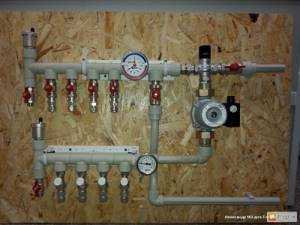
Manifold made of polypropylene.
Setting up the mixing unit
When the installation of the mixer is completed, they begin to check its suitability for operation. This usually takes longer than the installation itself.
The sequence of actions is as follows:
- First remove the servo. This must be done in order to prevent its influence on the mixing unit for the heated floor during the setup process. Set the bypass valve to the last division so that it does not accidentally operate during adjustment and is completely inactive.
- Then they begin to balance the contours. First of all, close the radiator circuit, or rather the shut-off balancing valve located on the first line. Remove the cap from the valve and move it clockwise to the end with a hex key. When setting up a mixing unit, the underfloor heating circuits are balanced using special valves. If there is one line, there is no need to perform balancing.
- If adjustments are necessary, the regulators are opened to maximum. The valve is closed in the circuit to the best size, achieving the greatest flow deviation.
- According to this scheme, the heating lines are adjusted as a whole. When the flow data gets lost during balancing, they are adjusted again. If it is not possible to adjust the flow rate with the valves open, then increase the operating speed of the pump.
- Next, we need to link the pumping and mixing unit for the water heated floor with other elements of the system. To do this, slightly open the radiator shut-off valve, which was closed before starting the adjustment. It is opened to an amount that corresponds to the optimal flow of coolant.
- Flow meters are used to control it. In addition, adjustment can be made through a return stroke in the system. Next, the valve pressure is set at the bypass valve. It should be no more than 10% of the highest pressure in the pump. The valve is activated when the unit begins to build up pressure at minimum water flow.
Making your own polypropylene comb
To work, you need to prepare two small polypropylene pipes with a diameter of 32 mm, as well as tees according to the number of bends. A quality product cannot do without threaded couplings, ball valves and direct radiator valves. Next, you can begin the manufacturing process itself; all actions must comply with the instructions:
- 1. Initially, you need to measure the depth of the pipe entering the tee (a small mark is placed on the outside). These two parts need to be soldered into a single structure.
- 2. From the edge of the fitting along the pipe, you need to set aside the same distance and cut off the part. The end must be cleaned. The adapter coupling must be carefully soldered to the lower outlet of the tee.
- 3. All manipulations must be repeated. When the second block is received, it must be compared with the first workpiece. After this, all actions are repeated.
- 4. An elbow or tee should be soldered at one end of the polypropylene for subsequent installation of the air vent. On the second side, a coupling for the ball valve is attached.
The manifold, which is made of polypropylene fittings, is the most budget option for arranging a warm water floor. Of course, this device has its drawbacks:
- There is no possibility to install flow meters.
- The design is quite large, which negatively affects the choice of protective box. To solve this problem, it is better to install the collector on the wall in the boiler room.
- The master must have excellent skills in the field of soldering polypropylene blanks. Otherwise, he may make mistakes while creating numerous joints.
Features of the mixing group device
A simple mixing unit for heated floors in a standard configuration consists of the following elements:
- valves - thermostatic and adjustment;
- thermostatic head;
- temperature control devices;
- pump

Both types of mixers with two- and three-way valves mix cold and hot coolant, forming a constant circulation.
The two-way valve is equipped with a thermal head having a sensor that checks the temperature in real time and, if necessary, stops the water supply from the boiler. The heated liquid begins to flow if it cools down when mixed with the return flow. This type of valve is used for rooms with an area not exceeding 200 square meters.
The three-way valve has a significant flow capacity. It is used for large and spacious rooms, where the heating system has many circuits, and ambient space controllers are also used.
Briefly about the main thing
The equipment of the collector block must meet the requirements for the functionality of the system. The collector device ensures uniform heating of the heating elements and a constant temperature in the room. Made from the following materials: polypropylene, brass and steel.
The manifold consists of a system to which threaded elements, fittings or control valves are connected. The collector is installed in a special cabinet or brackets are used.
Along with it, a mixing unit is used.
The durability of combs directly depends on the material and workmanship. You can purchase a ready-made distribution block or assemble it yourself from individual elements.
External floor heating sensors
Such devices are used for heating systems to ensure automatic adjustment of the degree of heating of the coolant depending on the weather. For example, when it gets cold outside the house, a signal is sent to increase the water heating temperature.
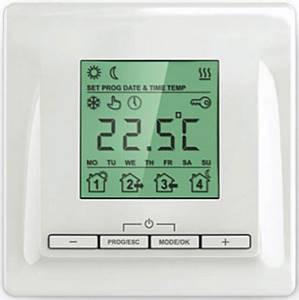
In case of warm weather, the sensor signals that it is warming and that the temperature parameters should be lowered. The design solution allows for rotation by 90 degrees. The controller has 20 sections and monitors the weather outside the house.
If the liquid temperature does not correspond to it, then the valve turns the required number of divisions. You can do this yourself, but with a weather sensor it is much more convenient to monitor the temperature outside the window.
Advantages of mixed floor heating
When there is a mixing unit for a heated floor, the heating system has many advantages:
- Comfortable stay . This is possible because thermal energy is supplied by radiation rather than by convection. In addition, the floor surface and rooms are heated evenly. There are no cold bridges or overly hot radiators in the rooms. All these circumstances contribute to creating a comfortable and healthy atmosphere and the absence of dust. The floor surface is always dry, there is no feeding environment for mites, mold and other harmful microorganisms.
- Financial benefit . With proper installation of pipes and efficient functioning of the structure, you can significantly save on heating your home. It has been proven that apartments consume about 30% less electricity, provided that the ceiling has a standard height.
- Safe operation . This circumstance is of no small importance for premises in which people are constantly present. Thanks to the functioning of the underfloor heating system and the way the mixing unit for heated floors works, residents do not have burns or other damage that can be caused when using, for example, convectors or oil radiators.
- Hygiene . A water floor system equipped with a mixer allows for periodic disinfection of the finished floor covering. It can be cleaned with detergents and water. This heating system is ideal for rooms with high hygiene requirements. For example, a water floor with a mixing unit can be installed in hospitals and preschool institutions.
- Convenience . For a water floor system, it is not necessary to install additional devices in the heated room. All the elements needed for it are usually placed in storage rooms. Therefore, when planning the interior of the room, no place is allocated for them.
Rules for choosing a collector
You can assemble a manifold for a warm water floor with your own hands or buy it ready-made
In the first case, it is important that all components are produced by one manufacturer. Some companies produce unique connecting elements that do not fit with parts from other suppliers, which threatens the assembled unit with loss of tightness
In the second case, when choosing equipment, you need to take into account several important points. First of all, you need to decide on the material from which the collector is made. It could be:
- copper;
- steel;
- brass;
- polymer.
In addition, collectors differ in the number of connected circuits, the number of which can vary from 2 to 12. The choice of device is based on an accurate calculation of the main parameters of the system and the required additional functions. Be sure to take into account:
- number of heating circuits, their length and transmission capacity;
- maximum pressure;
- ability to add branches;
- the presence of elements that automatically control the operation of the device;
- amount of electricity consumed;
- internal diameter of the collector.
The latter indicator should be selected so as to ensure maximum coolant flow in all heating circuits. The efficiency of the unit largely depends on the laying pitch, diameter and length of the pipes included in the heating circuit.
At the system design stage, these parameters must also be calculated. This is a rather labor-intensive undertaking that is best left to specialists. You can make the calculation using a special calculator program that can be found on the Internet.
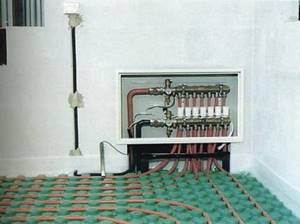
The collector will work most efficiently if heating circuits of equal length are connected to it. To do this, you may have to split too long branches into several short ones.
When making calculations, it is very important to take into account all system parameters. Otherwise, it will work unproductively: there may be insufficient coolant circulation or leakage, and a “thermal zebra” may also appear, as experts call uneven heating of the surface
To correctly determine the length of the circuit and the pipe laying pitch, you will need the following data:
- type of finishing floor covering;
- area of the room with a plan for the arrangement of large furniture and household appliances;
- pipe diameter and material;
- heating boiler power;
- type of thermal insulation used.
When making calculations, we must take into account that there should be no pipe joints in the circuit, since the use of couplings and connections under a concrete screed is strictly prohibited. In addition, we take into account the hydraulic resistance of the coolant, which will increase with each turn of the branch and as its length increases.
It is optimal if only circuits of equal length are connected to one collector. Perhaps the best solution for long branches is to divide them into several small ones.
Features of the arrangement of mixing units
A do-it-yourself mixing group for underfloor heating, in which warm liquid is mixed with cold liquid, is installed next to the heater. If the hydraulic elements of the system are connected using elastic tubes, then the unit must be firmly fixed to the wall.
Before starting installation, you must make sure there is space for unobstructed access to the mixer parts. The control valve should be placed in the area where the coolant enters the heater.
When choosing a pipe material, you need to make sure that it can withstand the temperature of the incoming fluid. Experts recommend purchasing polymer pipe products. It should be remembered that galvanized pipes cannot be used for glycol-water solutions.

It is desirable that the shut-off elements be made of brass and bronze, the tubes made of black steel, and the pumping equipment made of cast iron. Steel products for the system from the outside are primed and painted at the factory.
When choosing the location and connection of the unit, you need to remember about air bubbles that may appear from the outlet of the boiler circuit. It is also necessary to exclude the possibility of water or condensation getting on the system elements that are under voltage.
Taking into account the above information, we can conclude that the mixing unit should be selected individually so as to ensure maximum ease of use of the floor surface heating structure. You can choose the connection diagram yourself or purchase a completely ready-made design.
Separate requirements for gas equipment parameters
Heating using natural resources will have to be chosen correctly. Only in this case it is possible to avoid unnecessary negative emotions, waste of time, and loss of money.
All requirements are established by state standards. Their meaning is strict and unchanging. Linking directly to the area is due to technical capabilities. Which:
- 60 kW. Suitable for 2 meter ceilings. The room has 8 cubic meters of air volume;
- The boiler room is ventilated through three air exchanges. Combustion takes oxygen from a separate source. Kitchen window with window. The air flow is stable in both cases;
- There is a protective layer between the fasteners and the equipment itself. This is usually a sheet of metal. Its role is to prevent fire when the temperature rises during operation;
- the distance to the wall is at least 3 cm. The front side of the boiler allows it to be serviced on one square meter. From the sides, the distance from the unit is at least 60 cm;
- horizontal supply to the chimney no more than 3 meters. The diameter of the pipes used is the same as the heater. It's even better to connect a larger value. Then the hood is tougher.
Essentially, such requirements are checked by the company supplying gas to the house/building. It also allows the connection of such a device to a common highway. In the case of a gas holder, the owners of the premises check themselves. But it is worth remembering that their own lives are at stake.
There are no specific ones indicated for strapping. The gas boiler is connected to the floor heating system and then operates. Ensuring efficient work is compared with comfortable living conditions. An incorrect connection will affect the rest of the house.
The owners themselves are interested in proper connection by checking each parameter. It is better to place all aspects on the plan at the preparatory stage. Then it's easier to check.
We recommend: How to install xl pipe underfloor heating?
